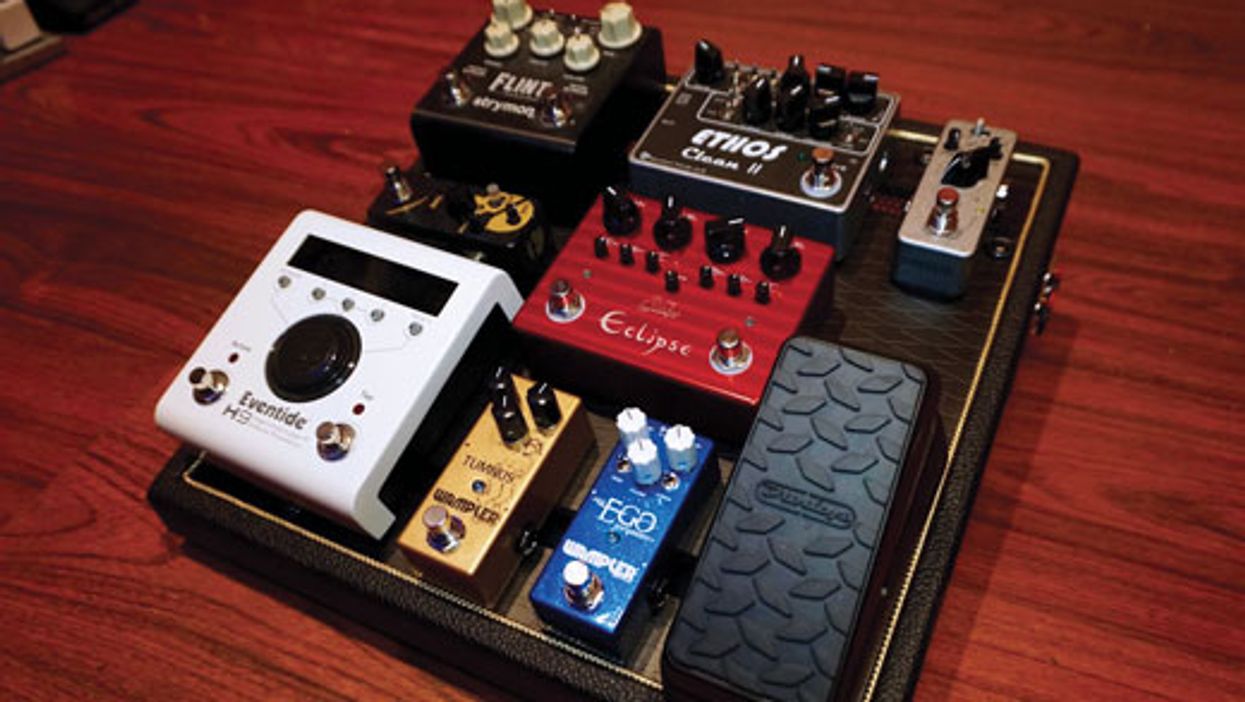Manufacturers of advanced digital pedals continue to pack more tons of horsepower into ever-shrinking enclosures. There are also more than a few pedals on the market that will take the place of a traditional guitar amp by including full-featured preamps, cabinet simulation, and more. Combined, these units open up all kinds of possibilities by allowing us guitarists to run either direct to a console, into a clean power-amp, or the effects return of a guitar amp. And consequently, it's getting easier than ever to do that session or fly date.
This month, I'm going to detail a powerful mini-pedalboard that can cover a huge range of tones and serve as an entire rig if necessary—no amp required. Be it compressed cleans with modulation, reverb, and delay, or on-the-edge rocking crunch, I want it all in a 14" by 14" package. Can it be done? (Note: All the components from this wide variety of manufacturers simply represent products I know and like, and are not intended to be endorsements. There are a lot of other excellent options out there.)
Small Footprint, Tons of Tone
Pedal No. 1. The Ethos Clean II preamp from Custom Tones Inc. was designed to essentially mimic the tone and response of a guitar amplifier. It can be used as a preamp and/or overdrive in front of a traditional guitar amp, but it can also be patched into a power amp and cabinet, or direct into a PA or recording interface. And because its output is buffered—even when bypassed—this supersedes the need for a standalone buffer on the board to keep the guitar signal strong and uncolored.
Pedal No. 2. I love having a volume pedal for volume swells and maintaining control over my level at my feet. Thanks to its tiny size, the smooth-action Volume X Mini from Dunlop fits the bill perfectly.
Pedals No. 3, 4, 5, and 6.My “attack of the minis" is a quartet of excellent tiny pedals for our tiny pedalboard. The first is a Wampler Mini Ego Compressor, which packs lots of compression versatility into a mini-format pedal and sounds great. Next up is a PhazeVibe from F-Pedals, a terrific-sounding, highly tweakable Vibe-style pedal. I've grown to love the sound of Klon-inspired pedals, and for a lead boost pushing an already dirty amp (or stacked with an amp-like drive), they have become my go-to thing. The Wampler Tumnus delivers the Klon magic in spades and it's tiny, so it's here on my pedalboard. I've also included the F-Pedals EchoBandit because it does a great job of capturing a warm, tape-delay character. And I'm using it old-school, in front of my Ethos “amp."
session or fly date.
Pedal No. 7. The Suhr Eclipse is a new dual overdrive/distortion pedal I chose to include. It has two identical channels—both with gain, volume, and full 3-band EQ. You can set one channel for an edgy overdrive or crunch sound and the other for full-distortion meltdown. Combined with the Ethos Clean II, you've got a 3-channel rig.
Pedal No. 8. Virtually any effect under the sun is packed into the Eventide H9, from delays to 'verbs to flangers to choruses. It's a Swiss Army Knife pedal for me and a must-have on my pedalboards.
Pedal No. 9. The Strymon Flint has become another favorite thanks to the luscious tremolo and beautiful reverb it produces.
Pedalboard and power supply. I went with a 14" x 14" V Board Pro from V Boutique. It's an angled pedalboard with ample space underneath for power supplies, cables, etc. Speaking of underneath, that's where a Strymon Ojai power supply is living. (If you're wondering where the tuner is, I suggest using a good headstock tuner like TC Electronic's PolyTune Clip to save valuable space on the pedalboard.)
Signal path and patching. The guitar plugs into an input on the right side of the pedalboard and the signal path order is as follows: Mini Ego, PhazeVibe, Tumnus, Eclipse, EchoBandit, Ethos Clean II, and Volume X Mini. The output of the volume pedal runs to the right side of the board and the input for the two final pedals (the H9 and Flint) is also on the right side of the board. This way, it's easy to use a short patch cable to run all the pedals in-line together and then direct the output of the last pedal (the Flint) to a guitar amp, a DI, or a power amp—in mono or stereo.
Or, I could run the output of the front end of the pedalboard (all the pedals up until the volume pedal) to a guitar-amp input and take the guitar amp's effects send and feed it to the H9 and Flint via the board's side jack. Then, the output of the Flint could be fed to the effect return of an amp, or the effect returns of two amps for a stereo rig.
There you have it! A miniature, incredibly powerful guitar rig. It would be totally feasible to fit this mini powerhouse into a decent-sized backpack or roller suitcase and carry it on an airplane. It's also something you could take to a session with ease. The producer will love the great tones and your back will stay in good shape for years to come. Until next month, I wish you great tone!














![Rig Rundown: Russian Circles’ Mike Sullivan [2025]](https://www.premierguitar.com/media-library/youtube.jpg?id=62303631&width=1245&height=700&quality=70&coordinates=0%2C0%2C0%2C0)




